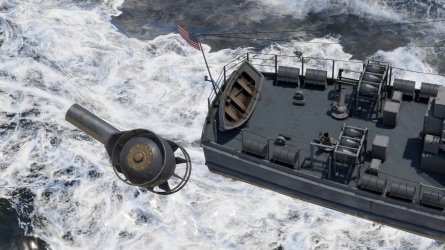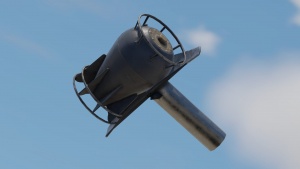K-gun Mk.9 depth charge

Contents
Description
Write an introduction to the article in 2-3 small paragraphs. Briefly tell us about the history of the development and combat using the weaponry and also about its features. Compile a list of air, ground, or naval vehicles that feature this weapon system in the game.
Vehicles equipped with this weapon
General info
Tell us about the tactical and technical characteristics of the bomb.
Effective damage
Describe the type of damage produced by this type of bomb (high explosive, splash damage, etc)
Comparison with analogues
Compared to its peers, Mk.6 has one of the largest explosive fillers and heaviest mass. It's launched off sides of the vessel.
| Name | Country of origin |
Mass (kg) | Explosive type |
Explosive mass (kg) |
TNT equivalent (kg) |
|---|---|---|---|---|---|
| 7.2 in T37 | |
29 | Torpex | 15.9 | 25.44 |
| B TG | |
63 | TNT | 50 | 50 |
| B TG 100 | |
126 | TNT | 100 | 100 |
| BAS | |
160 | Torpex | 70 | 112 |
| BB-1 | |
165 | TNT | 130 | 130 |
| BM-1 | |
45 | TNT | 25 | 25 |
| Guiraud | |
176 | TNT | 130 | 130 |
| K-gun Mk.9 | |
190 | TNT | 136 | 136 |
| Limbo mortar | |
177 | Minol | 94 | 108.1 |
| Mk.10 Hedgehog mortar | |
29 | Torpex | 15.9 | 25.44 |
| Mk.4 | |
160 | Minol | 94 | 108.1 |
| Mk.6 | |
190 | TNT | 136 | 136 |
| Mk.6 mortar | |
190 | TNT | 136 | 136 |
| Mk.9 | |
190 | TNT | 136 | 136 |
| Mk.VII | |
196 | TNT | 130 | 130 |
| RBM mortar | |
160 | Amatol | 70.8 | 70.8 |
| Type 3 | |
50 | Type 88 | 20 | 26 |
| Type 95 | |
160 | Amatol | 100 | 100 |
| WBD | |
196 | Amatol | 130 | 130 |
| WBF | |
139 | Amatol | 60 | 60 |
| WBG | |
160 | Amatol | 100 | 100 |
| Y-gun Mk.VII | |
196 | TNT | 130 | 130 |
Usage in battles
Describe situations when you would utilize this bomb in game (vehicle, pillbox, base, etc)
Pros and cons
Summarise and briefly evaluate the weaponry in terms of its characteristics and combat effectiveness. Mark pros and cons as a list.
Pros:
Cons:
History
The K-gun Mark 9 was a prototype method for a depth charge launcher that was based on testing that began in World War I. The K-gun was an improved version of the Y-gun tested during World War I and adopted after the war ended. The K-gun Mark 6 had already replaced the Y-gun as the principal depth charge launcher in 1942. The Mark 6 used a design with an arbor fitted inside the projector to hold the depth charge in place and detached after both were launched as a unit overboard. In 1944, the United States Navy tested a slight upgrade to the K-gun the Mark 9. The most significant change was the inclusion of a built-in arbor and cradle. The cradle and arbor helped reduce weight. Tested on the USS Asheville, the program was canceled on the grounds that the weight reduction was marginal and not enough to justify replacing the existing K-gun Mark 6s.
Media
Excellent additions to the article would be video guides, screenshots from the game, and photos.
See also
Links to the articles on the War Thunder Wiki that you think will be useful for the reader, for example:
- reference to the article about the variant of the cannon/machine gun;
- references to approximate analogues by other nations and research trees.
External links
Paste links to sources and external resources, such as:
- topic on the official game forum;
- other literature.
| Naval depth charges | |
|---|---|
| USA | Mk.6 · Mk.6 mortar · K-gun Mk.9 |
| Germany | WBD · WBF · WBG |
| Foreign: | BB-1 (USSR) · Mk.6 (USA) · Type 95 (Japan) |
| USSR | BB-1 · BM-1 · MBU-600 mortar · RBM mortar |
| Britain | Limbo mortar · Mk.10 Hedgehog mortar · Mk.VII · Y-gun Mk.VII |
| Foreign: | Mk.6 mortar (USA) |
| Japan | Type 3 · Type 95 |
| Foreign: | Mk.6 mortar (USA) · Mk.9 (USA) · Mk.10 Hedgehog (Britain) |
| Italy | B TG · B TG 100 · BAS · Mk.4 |
| Foreign: | WBG (Germany) · Mk.10 Hedgehog (Britain) |
| France | Guiraud |
| Foreign: | Mk.VII (Britain) · Y-gun Mk.VII (Britain) |




